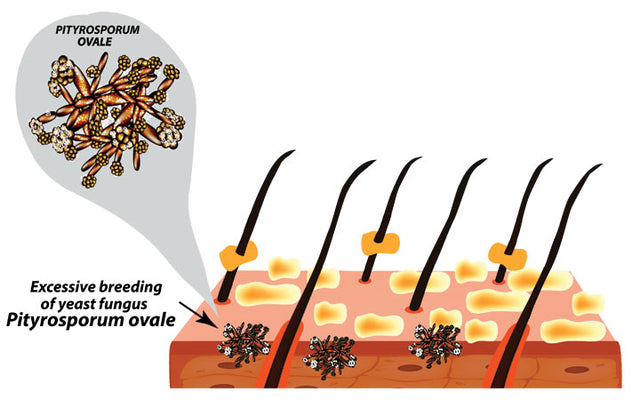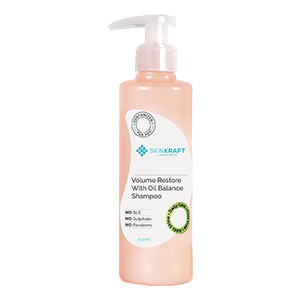Have you noticed any red bumps on your face that feel particularly itchy? Did you think it was simply an acne breakout? Well, it could be a much more serious condition, often mistaken for acne.
If you have been noticing small uniformly-sized itchy papules on your face, neck or chin, Malassezia folliculitis could be the reason. Set up an appointment with a dermatologist at the earliest. Understand about the condition and what causes it through this article.
Highlights:
What Is Pityrosporum Folliculitis?
Malassezia (Pityrosporum) folliculitis is a fungal condition that is often misdiagnosed as normal acne. However, this infection is caused by the invasion of a yeast known as Malassezia on your hair follicles. It can persist for several years. (1)
What Does Pityrosporum Folliculitis Look Like?
Malassezia folliculitis or Pityrosporum folliculitis, which is an infection of hair follicles, manifests in the form of small fluid-less itchy red spots on certain parts of your body, including your face and neck and upper limbs. Get a clinical examination done to diagnose pityrosporum folliculitis.
Some of its common symptoms are:
- Small itchy bumps called pustules or papules.
- These pustules, focused on hair follicles, are usually found in the upper part of the body- shoulders, chest and upper back and face.
- You will notice that oilier areas of your body tend to get affected more.
Does Pityrosporum Folliculitis Spread?
Even though most types of folliculitis aren’t contagious, it could very well spread to other body parts if you scratch at the bumps and then touch another part of your body. Folliculitis can generally spread from used towels or razors as well. Very close skin to skin contact can also spread this condition.
What Causes Pityrosporum Folliculitis?
- Use of antibiotics or physical conditions which suppress your immunity could help Malassezia to overgrow and cause breakouts on your skin surface.
- Other triggers of pityrosporum folliculitis include humidity and excess oil production.
- Steroids consumed orally and even from use of certain emollients and sunscreens can lead to this condition.
- You may notice that your pityrosporum folliculitis may be flaring up more often during summer months when the weather is more humid.
- It could also be triggered whenever you sweat too much.
How Do You Treat Pityrosporum Folliculitis?
Mild cases of folliculitis can heal by itself in a fortnight's time. If not treated properly and on time, pityrosporum folliculitis has a tendency to manifest repeatedly and over long periods of time. Here are some ways to treat the infection:
1. Home Remedies
To ease itching, use a warm compress on the affected area. Soak a hand towel in warm water and squeeze out the excess water before placing the warm towel on affected areas of the skin. This will help with healing the itchy bumps and bringing about a sense of relief.
2. Medical Treatments
Drugs to treat pityrosporum folliculitis are also available. Medicines used to treat fungal infections, such as fluconazole may be prescribed by doctors. Fluconazole has been known to be effective in fighting yeasts Malassezia and candida. (2)
Oral intake of anti-fungal medication has been known as the best treatment for quick results in treating pityrosporum folliculitis. (3) Laser treatment for hair follicles to prevent inflammation is also available to treat pityrosporum folliculitis.
3. Over The Counter Treatments
You could also try using medicated shampoo for taking care of folliculitis that is affecting your scalp or beard. You can let the shampoo run over the affected areas in your skin as well. Studies have shown that shampoos rich in the ingredient selenium sulphide can be effective in treating pityrosporum folliculitis. (4)
How Can You Tell The Difference Between Folliculitis And Acne?
The major difference between the two skin conditions is that while both cause pain and red bumps to appear on your face, with folliculitis, there is an itchy sensation on the bumps as well.
Folliculitis, in some cases, could even affect deeper layers of your hair follicles. Acne is simply caused by clogged pores and excessive oil build-up and is more common.
While acne usually occurs in places with excess oil build up, such as your face, this is not the case with folliculitis.
Folliculitis is not only caused by the fungi Mallasezia but could also be caused by certain bacteria and viruses. This skin infection could affect the outer surface of your skin and might look very similar to an acne breakout. So be sure to get a doctor’s opinion on this.
When To Consult A Doctor?
If the irritation doesn’t go away in about two weeks, or if you are seeing signs of the condition getting worse, you might want to get expert help at the earliest. Set up an appointment with a doctor if the infection keeps spreading or keeps recurring.
It is also best to consult a doctor if you have the symptoms of pityrosporum folliculitis and also have a fever that is over 101°F. This also applies if the infected area is giving you too much pain or if it is showing signs of becoming reddish in colour, swollen or feels warm. (5)
Wrapping Up
Remember that bouts of pityrosporum folliculitis infections could persist for long periods of time, giving you grief for several years if it gets misdiagnosed as common acne. So, diagnosis is key.
Once properly diagnosed, there are topical treatment solutions as well as oral medications available for treating this infection. Apart from following a treatment plan prescribed by a doctor, you can make sure to keep a few risk factors in check. Avoid wearing tight and uncomfortable clothing that you may sweat in- this could only trigger folliculitis. Sometimes, usage of emollients and certain sunscreens can end up triggering a pityrosporum folliculitis infection, so always get expert opinion before picking products.
Recommended Products
Was this Article helpful?
- Least helpful
- Most helpful











